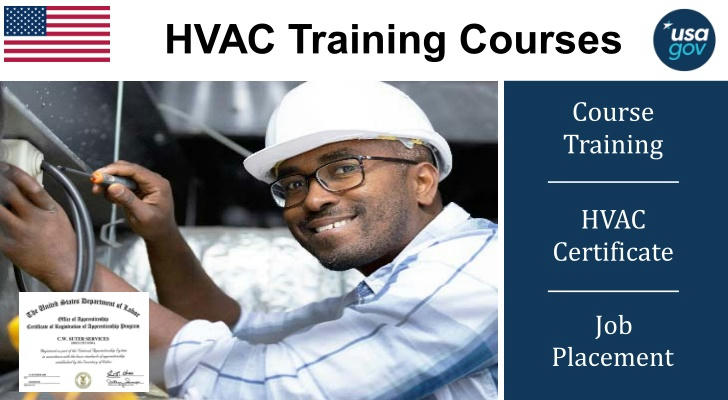Paid HVAC training supported by the US government: over $27 per hour!
According to the Bureau of Labor Statistics, jobs for HVAC technicians and installers are expected to grow 5% from 2021 to 2031, adding approximately 20,200 new positions. To meet the demand for skilled workers in this field, the US government supports paid HVAC training programs through a variety of funding programs to help those who are interested in this field earn income while learning skills. Participants in this program can earn $18 to $23 per hour during their studies (data from the US Office of Apprenticeship). After graduation, contracted companies generally offer hourly wages of $27+ and promise 90% job security. What are you waiting for? Come and learn about entering this high-paying industry!

Government-supported paid training programs
To address skill shortages and support workforce development, the US government has funded many paid HVAC training programs through federal and state programs. These programs are usually centered on apprenticeship, combining classroom learning and on-the-job training, allowing participants to earn wages while they study. Here are some typical government support mechanisms:
✅ Workforce Innovation and Opportunity Act (WIOA)
WIOA is an important piece of federal legislation that provides job training funding for unemployed or underskilled workers. Many state WIOA programs partner with local community colleges or vocational schools to provide HVAC training. Participants may receive up to $8,000 in training grants, and in some programs, they can also obtain paid internships through partnerships with employers. For example, organizations such as the HVAC Technical Institute are accredited by WIOA to provide students with funding and employment support.
✅ Registered Apprenticeship Programs
Registered apprenticeships, supported by the U.S. Department of Labor, are the core model for paid HVAC training. These programs typically last 3 to 5 years and include 144 hours of classroom learning and 2,000 hours of on-the-job training per year. Apprentices receive progressively increasing wages during their work. For example, at Chemeketa Community College in Oregon, apprentices complete 576 hours of classroom learning and 8,000 hours of on-the-job training in four years.
✅ Veterans Education Benefits (GI Bill)
For eligible veterans, the U.S. Department of Veterans Affairs provides educational assistance through the GI Bill, including HVAC career training. Veterans can choose to participate in an approved apprenticeship or vocational school program, receive a living allowance during their studies, and gain experience through paid work.
✅ State Initiatives
States have also launched their own programs. For example, Indiana's "Ivy Tech Community College" provides HVAC certificate training through the "Next Level Jobs" program, funded by the state government's Workforce Ready Grant. Wisconsin's "Department of Workforce Development" provides HVAC apprentices with 8,440 hours of paid on-the-job training and related certifications.
What are the benefits of choosing government-supported paid HVAC training?
Debt-free learning: Compared to traditional college or private vocational school tuition that can easily cost thousands of dollars, participants do not incur debt and can earn income while learning.
Practice-oriented: The program focuses on hands-on practice, and apprentices learn to install, maintain, and repair HVAC systems in a real work environment, ensuring that skills are seamlessly connected to market needs.
Job security: After completing training, participants can usually obtain industry-recognized certifications (such as EPA 608 certification or NATE certification) and have a high employment rate.
Flexibility: Many programs are suitable for working people or those who need to balance family life, providing daytime or evening course options.
With climate change and the increasing demand for energy efficiency, the future of the HVAC industry will be brighter. The government is expected to continue to increase investment in the training of skilled workers, and the paid training model may expand to more regions and professional fields.
Real case: Single mother's breakthrough
Maria (pseudonym), a single mother from Idaho, lives with two children and used to work in the service industry with unstable income. She wanted to find a career that could provide a better life. Therefore, Maria began her career change through the HVAC apprenticeship program of College of Western Idaho (CWI). This program is supported by the U.S. Department of Labor and adopts a "learn while earning" model. She works 35 hours a week at an HVAC company, with a starting salary of $16 per hour, while taking online and evening courses, and her tuition is covered by government subsidies. During the three-year apprenticeship, Maria gradually mastered the installation and maintenance skills of HVAC systems, and her salary increased to $22 per hour. In 2023, she completed her apprenticeship, obtained state certification, and became an entry-level technician. She said: "This program not only gave me skills, but also allowed me to take care of my children. Now I can provide them with a better life."
How to Get Started
Follow the steps below and make the most of the resources available to you.
How to apply for a paid HVAC training program supported by the US government?
1️⃣ Research local programs: Visit the U.S. Department of Labor's apprenticeship website (apprenticeship.gov) or the official website of each state's workforce development department to find nearby registered apprenticeship opportunities.
2️⃣ Contact training institutions: Community colleges (such as Howard Community College) or unions (such as Pipe Fitters’ Local Union 597) are usually partners in the program and can provide specific application information.
3️⃣ Confirm Eligibility: Most programs require applicants to be 18 years of age or older, have a high school diploma or GED, and pass a basic competency test (such as WorkKeys).
4️⃣ Apply for Funding: Apply for funding through the WIOA office or the Department of Veterans Affairs to ensure financial security during training.
5️⃣ Interview & Registration: Contact the employer or training provider to complete the interview and officially join the program.
Paid HVAC training funded by the US government has provided countless people with life-changing opportunities. By combining education, practice, and income support, these programs not only help participants master a practical skill, but also pave the way for them to achieve career success. If you are interested in hands-on work and want to find a foothold in a high-demand industry, you might as well take action now and explore training opportunities in your area!

